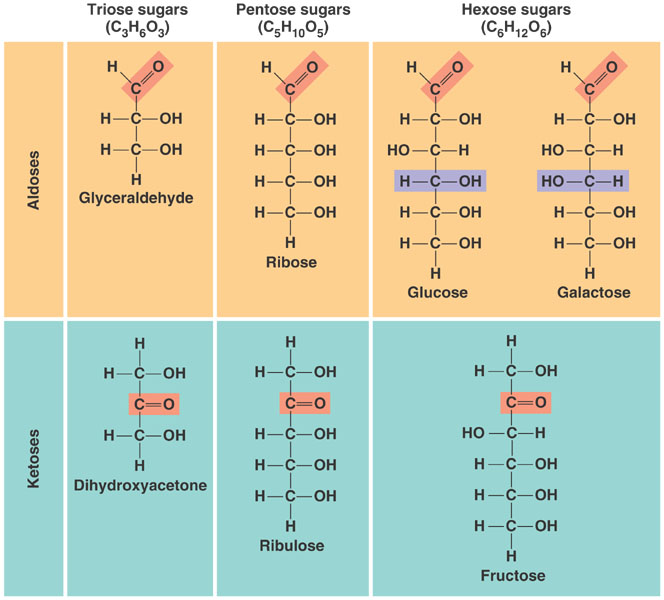Before jumping into the metabolic pathways thought let's review a bit of sugar chemistry and analyze the structural differences between fructose and glucose. Structure is a key factor in our how molecules are used by our body and even small differences in structure can cause big differences.
Both fructose and glucose are monosaccharides meaning they are are the building blocks of all carbohydrates. Sucrose is a disaccharide formed by one molecule each of fructose and glucose. All monosaccharides have the formula CnH2nOn where n is at least 3. Simple monosaccharides consist of carbon chain containing one carbonyl group and then one hydroxyl group on all the remaining carbons. Here are some examples of common simple monosaccharides:
 As you can see from the images, the key defining characteristics of a monosacharide are the number of carbons, position of the carbonyl group and the orientation of each of the hydroxyl groups. With the exception of the first and last carbon molecules, any carbon with a hydroxyl group is a chiral center, meaning that the orientation of the attached molecules changes the strucutre and therefor chemical properties of the sugar. The images shown above are called Fisher projections and are a common why to represent sugars.
As you can see from the images, the key defining characteristics of a monosacharide are the number of carbons, position of the carbonyl group and the orientation of each of the hydroxyl groups. With the exception of the first and last carbon molecules, any carbon with a hydroxyl group is a chiral center, meaning that the orientation of the attached molecules changes the strucutre and therefor chemical properties of the sugar. The images shown above are called Fisher projections and are a common why to represent sugars.Fructose and glucose have some common characteristics. Both are hexoses, meaning they have a 6-carbon backbone and share the chemical formula C6H12O6. An immediately obvious difference though is the position of the carbonyl. In glucose the carbonyl is on the #1 carbon making it an aldehyde. The carbonyl on fructose is on the #2 carbon so it is a ketone. The orientations of the hyrdoxyl groups on the remaining carbons are the same.
The alcohol end of the sugar can react with the carbonyl carbon to form a cyclic structure. Monosaccharides with 5 or 6 carbons often perfer this structure. Due to the different locations of the carbonyl group, fructose will form a 5 member ring called while glucose will form a 6 member ring. Here is a representation of the cyclic structures of glucose and fructose called Hawthorn projections:
 Now why go through all this trouble to understand these structural differences? Well, as mentioned earlier differences in structure, even very small can have a large impact on how the molecules are used by the body. Some enzymes can be specific for only one type of molecule. While we think of fructose and glucose as just two sugars, to our bodies they are two distinct molecules. They even have different relative sweetness. Fructose is actually about 1.74 times sweeter than sucrose while glucose has about .75 the sweetness of sucrose.
Now why go through all this trouble to understand these structural differences? Well, as mentioned earlier differences in structure, even very small can have a large impact on how the molecules are used by the body. Some enzymes can be specific for only one type of molecule. While we think of fructose and glucose as just two sugars, to our bodies they are two distinct molecules. They even have different relative sweetness. Fructose is actually about 1.74 times sweeter than sucrose while glucose has about .75 the sweetness of sucrose.While fructose and glucose are different structurally, this doesn't immediately imply that one is bad or better than the other. Actually this doesn't even imply that they are processed by the body in significantly different ways. It just means that they might, and because of the possibility it worth digging a little deeper and understand the difference in metabolism of these two common sugars.